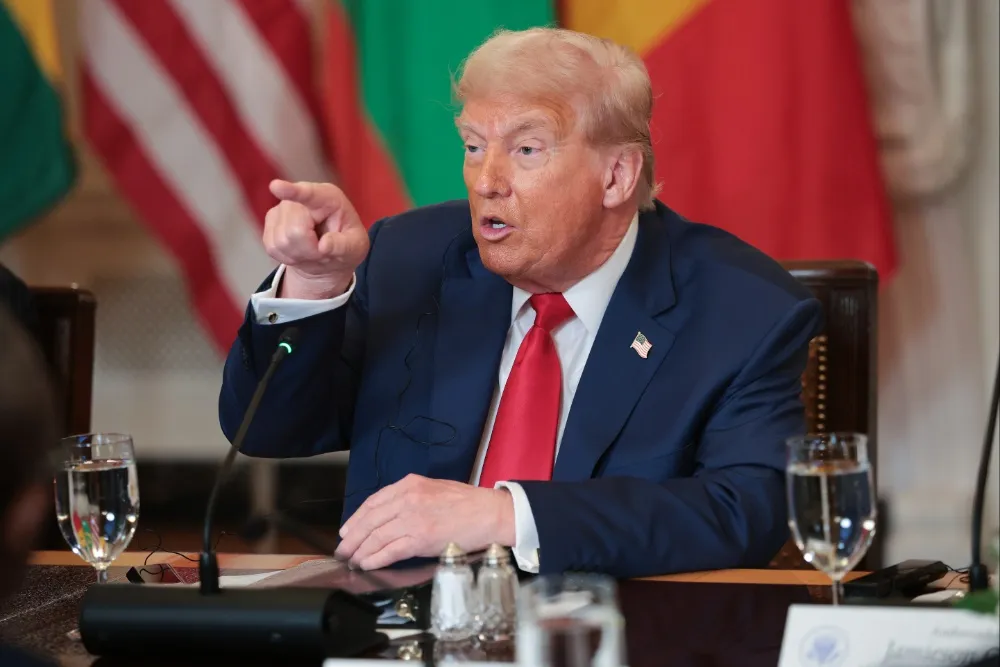Donald Trump threatens Canada with a 35% tariff on imported goods if he returns to office. The warning came amid a new surge of tariff-related letters sent to various international trade partners, further escalating concerns of a possible trade war under a future Trump administration.
While Trump has previously imposed tariffs on global trade partners during his presidency (2016–2020), this fresh warning is being viewed as a particularly aggressive stance toward Canada, one of the United States’ closest allies and top trading partners.
This article explores the potential impact of the 35% tariff threat, reactions from Canadian officials and business leaders, and what this could mean for North American trade in the near future.
Why Trump Is Targeting Canada Now
In recent months, Donald Trump has been ramping up his campaign messaging, which often includes bold economic claims and aggressive foreign policy stances. In a series of letters reportedly sent to trade officials in allied countries—including Canada—Trump has made it clear that he plans to take a much harder line on imports if reelected.
According to sources familiar with the letters, the Trump campaign is laying the groundwork for a new tariff regime that includes significant penalties for what he describes as “unfair trade practices.” One of the most startling elements of these communications was the suggestion of a 35% tariff on Canadian imports, including automobiles, steel, aluminum, and even agricultural products.
While Trump has not yet officially confirmed the letter, his past trade policies and campaign rhetoric suggest that such measures are very much in line with his broader strategy of “America First.”
Canada’s Reaction to the 35% Tariff Threat
The Canadian government and business community were quick to respond to the threats.
Official Government Response
Chrystia Freeland, Deputy Prime Minister of Canada, stated:
“Canada has always believed in fair and balanced trade. We will protect Canadian interests and workers from any unjustified trade actions.”
Freeland also emphasized that Canada remains committed to the USMCA, the current trade agreement between the U.S., Mexico, and Canada, and hopes that cooler heads will prevail if Trump returns to office.
Canadian Business Leaders Speak Out
Business leaders across various industries in Canada expressed deep concern over the potential tariff hike. The Canadian Chamber of Commerce released a statement saying:
“A 35% tariff would be catastrophic for Canadian exports and deeply harmful to U.S. supply chains that rely on Canadian materials and goods.”
Many Canadian companies, especially in manufacturing, auto parts, and agriculture, worry that new tariffs would force layoffs, plant closures, and increased prices for consumers on both sides of the border.
What Could a 35% Tariff Mean for the U.S.?

Although Trump’s intention is to bring jobs back to America and punish foreign competitors, economic experts warn that such steep tariffs could backfire.
Higher Prices for American Consumers
Most Canadian imports—such as lumber, automotive parts, and food products—are vital to U.S. supply chains. If a 35% tariff were applied, American manufacturers would face higher production costs, which would likely lead to:
- Increased prices for cars, furniture, and packaged foods.
- Higher construction costs due to more expensive lumber.
- Delays in production due to supply chain disruptions.
Possible Job Losses in the U.S.
While Trump’s goal is to protect U.S. workers, retaliatory tariffs from Canada could lead to job losses in U.S. industries that export to Canada. These include:
- Agriculture (especially dairy, soy, and wheat)
- Heavy machinery and equipment manufacturing
- Technology and electronics
Canada is the second-largest trading partner of the United States, and over $700 billion in goods and services are traded annually between the two countries. Disrupting that flow could seriously impact both economies.
Is This Legally Possible Under USMCA?
The USMCA (United States-Mexico-Canada Agreement) replaced NAFTA in 2020 and sets clear rules for trade among the three nations. Under this agreement, arbitrary tariffs—especially at the scale of 35%—would likely violate its terms.
However, Trump has shown in the past that he is willing to invoke national security clauses to bypass trade agreements. In 2018, his administration imposed tariffs on Canadian steel and aluminum using such justifications, even though Canada was a close ally.
Trade lawyers suggest that if Trump were to win the 2024 election, he could again use executive powers to sidestep certain USMCA clauses, leading to another round of legal battles and diplomatic tensions.
Economic Experts Weigh In
Economists have voiced concerns over the long-term impact of such tariffs.
Paul Krugman, Nobel Prize-winning economist, wrote on social media:
“A 35% tariff is not protectionism; it’s economic sabotage. U.S. consumers and small businesses will be the biggest losers.”
Meanwhile, Danielle Goldfarb, head of global research at a Canadian economic think tank, noted:
“Tariffs of this size would lead to an inflationary shock. It would hurt the very middle-class workers Trump claims to protect.”
Goldfarb also pointed out that previous Trump-era tariffs led to job losses in certain U.S. industries and hurt American farmers, who faced retaliation from Canada, China, and other trade partners.
Rising Fears of a Global Trade War
Trump’s tariff threats are not limited to Canada. Reports suggest that similar letters were sent to European and Asian trade partners, warning them of increased tariffs if Trump wins the 2024 election.
If Trump follows through with these threats, the world could face:
- Multiple trade disputes at the World Trade Organization.
- Devaluation of global currencies as nations adjust to higher export costs.
- Reduced international cooperation on supply chain resilience and climate goals.
In short, Trump’s return could trigger a new era of trade instability.
The Political Motivation Behind the Move
Political analysts believe that Trump’s hardline trade threats are part of a broader election strategy aimed at energizing his base.
By blaming foreign countries for economic challenges, Trump aims to:
- Present himself as a tough negotiator.
- Distract from domestic issues like inflation and job losses.
- Stir nationalist sentiment among voters.
However, this tactic comes with risks. If voters see prices rise or jobs lost due to trade instability, support could quickly erode, especially in battleground states reliant on exports or manufacturing.
Possible Canadian Countermeasures
If Trump were to impose a 35% tariff, Canada has several options:
- Retaliatory Tariffs: Imposing similar or higher tariffs on U.S. goods.
- Seeking WTO Arbitration: Although slow, this could pressure the U.S. diplomatically.
- Strengthening Ties with Other Trade Partners: Canada may look to expand agreements with the EU, Asia-Pacific nations, and Latin America.
Freeland has already hinted at Canada’s readiness to “defend its economic sovereignty”.
What Happens Next?
With the U.S. election approaching, this issue is likely to stay in the headlines. A few possible scenarios could unfold:
- Trump wins and follows through – resulting in a major trade war and significant economic impacts.
- Trump softens stance post-election – using the threat as a bargaining chip to negotiate better deals.
- A legal challenge blocks the tariff – based on USMCA or constitutional limits.
- A different candidate wins – restoring trade normalcy and confidence among global markets.
Regardless of what happens, businesses and governments are now on high alert.
Final Thoughts
The news that Trump threatens Canada with a 35% tariff is more than just a campaign talking point—it signals a possible return to volatile and unpredictable trade policies. While some see it as a way to bring manufacturing jobs back to the U.S., the broader consensus among experts and officials is that such a move could harm both American and Canadian economies.
As the election draws nearer, both countries must prepare for a range of outcomes. In the meantime, the threat of new tariffs is already influencing investment decisions, trade strategies, and political alliances.
Whether Trump’s threats become reality or remain campaign rhetoric, the ripple effects are already being felt—and they could shape the future of North American trade for years to come.
Read Next – State Department Layoffs to Begin Soon, Officials Confirm






